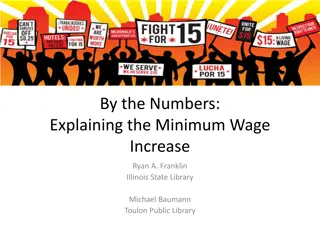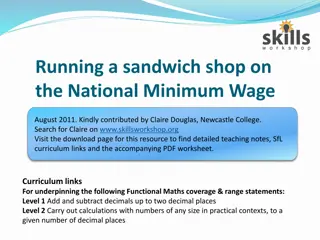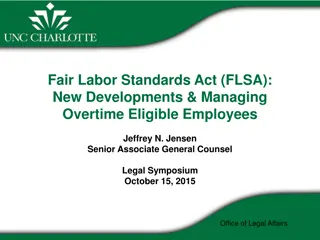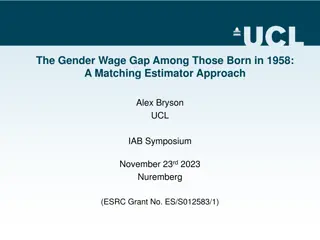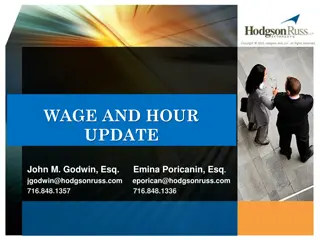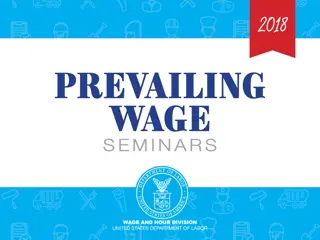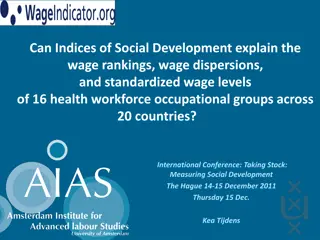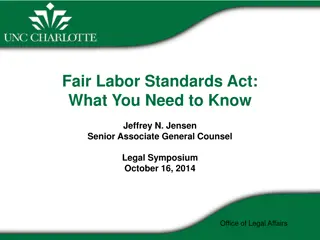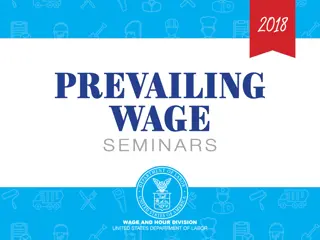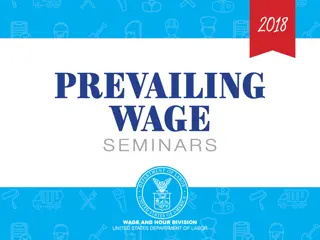Understanding Current Wage & Hour Developments with Derrick T. Wright
Delve into the latest wage and hour developments with Derrick T. Wright, covering topics such as minimum wage, child labor laws, equal pay, overtime requirements, worker classification, and the intricacies of independent contractors. Explore the basics, exemptions, and common issues related to wage and hour regulations to ensure compliance in your workplace.
Download Presentation

Please find below an Image/Link to download the presentation.
The content on the website is provided AS IS for your information and personal use only. It may not be sold, licensed, or shared on other websites without obtaining consent from the author. Download presentation by click this link. If you encounter any issues during the download, it is possible that the publisher has removed the file from their server.
E N D
Presentation Transcript
Where are we now? The latest Wage and Hour developments Derrick T. Wright
Getting Started: What do Wage & Hour laws refer to? Minimum Wage Child Labor Laws Equal Pay Overtime Requirements
Getting Started: Where do overtime requirements come from? Federal & State Statutes Fair Labor Standards Act (FLSA) found in 29 U.S.C. 201 o Implementing Administrative Regulations o Department of Labor in 29 C.F.R. Chapter V Court Review & Precedent
Getting Started: What are the most common overtime issues? Worker Classification Compensation Practices Compensable Time
Worker Classification: Basics Wage and hour overtime requirements do not apply to all workers. There are two types of exceptions from overtime requirements: 1) If the worker is not an employee as defined by law (i.e., is not covered) 2) If the worker is an employee, but qualifies for an exemption (i.e., is exempt ) The process to evaluate whether workers are covered or exempt usually is referred to as classification.
Worker Classification: Who are employees? Wage and Hour laws have an extremely open-ended definition of employment to suffer or permit to work. Covered employees, if otherwise nonexempt, must be paid overtime when they work over 40 hours in a single workweek. The rate for overtime is one and one-half times the normal hourly rate.
Worker Classification: Which workers are not employees? STUDENT WORKERS INDEPENDENT CONTRACTORS VOLUNTEERS
Worker Classification: Past Independent Contractor Tests and Turmoil Historic six-factor Economic Realities Test had been used. Court decisions exhibited mixed emphasis and mixed results. Under Trump administration, new DOL rule prioritized two factors: Opportunity for profit or loss; and Nature and degree of employer s control over the work.
Worker Classification: What is the current Independent Contractor framework? Latest rule change returns to totality of working relationship analysis. Expect courts and agencies to start with the historic six factors. Additional unspecified factors can be considered. No single factor or set of factors is determinative. Worker economic dependence or independence is the ultimate inquiry.
Worker Classification: Independent Contractor Economic Reality Factors & Examples 1. Whether the worker has an opportunity for profit or loss depending on managerial skill Landscaper control over assignments through advertising, negotiating, and staffing. 2. The investments by the worker and the potential employer Graphic designer responsibility for purchasing equipment or infrastructure. 3. The degree of permanence of the work relationship Exclusiveness of caterer s work relationship with entertainment venue.
Worker Classification: Independent Contractor Economic Reality Factors & Examples 4. The nature and degree of control by the employer over the worker Nurse s control over rate of pay, restrictions on outside employment, and supervision over scheduling. 5. The extent to which the work performed is an integral part of the potential employer s business Farm operation hiring accountants to prepare annual taxes or workers to harvest produce. 6. The skill and initiative required Welder marketing customized services.
Worker Classification: Students can be Employees Generally, most student workers are hourly non-exempt employees. An employment relationship exists when a student receives compensation and his or her duties are not part of an overall education program. Historic student-worker limitations Graduate Teaching Assistants: fall under teaching exemption when their primary duty is teaching. o Research Assistants: generally, an educational relationship exists when the student performs research under faculty supervision. o Residential Assistants: generally, students who are in an educational program and receive reduced room or board charges or tuition credit are not employees o
Worker Classification: Is the NRLB turning Student-Athletes into Employees? Dartmouth University men s basketball players recently deemed school employees by Regional National Labor Relations Board director Cited grounds for the decision included: Student athletes benefited Dartmouth as an institution o Non-scholarship student athletes were still compensated through room and board, apparel, game tickets, and academic and fitness support o Dartmouth s Student-Athlete handbook and student-athlete program gave the university significant control over the athletes. o
Worker Classification: What are the limits of the NLRB Dartmouth decision? Public universities are not within NLRA private employer regulation. Prior NLRB regional director decision found Northwestern football players were employees was withdrawn due to competitive disadvantage with public Big Ten schools. o Emerging argument to extend NLRB reach by treating universities as joint employer with conferences and/or the NCAA currently under review before California NLRB regional director. o NLRA does not set minimum labor standards such as minimum wages, but rather sets the stage for labor-management engagement.
Worker Classification: What are the limits of the NLRB Dartmouth decision? Dartmouth decision subject to appeal to full Board and review by courts. Federal appellate court decisions from 2016 and 2019 have rejected student-athlete FLSA claims purporting to be employees of their university or joint employees of the conference or NCAA o Potentially conflicting federal district court case out of Pennsylvania declined to dismiss student-athlete FLSA claims against university and NCAA is pending on appeal. o The tradition of amateurism has been a major focus of the debate. o
Worker Classification: What Employees are exempt? Executive Employees Administrative Employees Professional Employees
Worker Classification: White-Collar Exemption To qualify for a white-collar exemption, an employee must generally satisfy three tests: 1. Paid on a salary basis that is not subject to reduction based on the quality or quantity of work (the salary basis test ), rather than, on an hourly basis; 2. Receives a salary at a rate not less than $684* per week (the salary level test ); and 3. Performs primary duties consistent with one or more exemption category, (the duties test ). *Note the salary rate of $684 is set to be changed (as discussed below)
Getting Started: What are the most common overtime issues? Worker Classification Compensation Practices Compensable Time
Compensation Practices: Not all exempt employees come under the salary basis requirement The minimum salary basis requirement is inapplicable to: Doctors; Lawyers; Teachers; Academic administrative employees; and Outside salespersons. All other exempt employees must be paid a minimum salary set by regulation to qualify.
Compensation Practices: Twenty Years of Growing Minimum Salary Tumult 2004 Adjustment for inflation to $23,660 ($455 per week) 2016 Major rule amendment to $47,476 blocked by court injunction 2020 Scaled down amendment to $35,568 ($684 per week) 2024 Rule amendment to: $43,888 ($844 per week) effective 7/1/2024 $58,656 ($1,128 per week) effective 1/1/2025 Automatic updating every three years thereafter
Compensation Practices: 2024 FLSA Final Rule Minimum salary equal to 35thpercentile of full-time salaried workers in the lowest-wage Census Region (Northeast, Midwest, South, and West). Based on Bureau of Labor Statistics survey and published quarterly. Level marking next update will be published 150 days before taking effect. The update can be delayed where unforeseen economic or other conditions warrant Note: Corresponding bifurcated increase for Highly Compensated Exception from $107,432 annual salary to $132,964 and then $151,164. $151,164 equals the 85thpercentile of annual salaries nationwide o
Compensation Practices: 2024 FLSA Final Rule Impact and Strategies The Labor Department estimate approximately 4 million workers affected. Probably undercounted according to commentators. How to adapt: Find the doughnut hole: Current exempt salaries between $35,568 and $58,656. Estimate average work hours per week to make proportional hourly rate conversion. Easier conversion for employees with regular, fixed work schedules; Employees with variable work schedules will present harder challenge.
Compensation Practices: 2024 FLSA Final Rule: Potential Challenges DOL has regulatory authority to define and delimit the white-collar exemption based on duties and salary, but overly large minimum salary increase was held to impermissibly supplant the duties test. A Texas District Judge blocked a 2016 increase in the salary level on this basis, noting the significant difference in amount and the estimated impact on 4.2 million workers. o At least three Supreme Court Justices have flagged the issue. o The automatic increases were previously challenged for violating the Administrative Procedures Act, but that issue was not resolved.
Compensation Practices: Will the standard 40-hour workweek be lowered? Current 40-hour workweek was a historical norm legislatively incorporated into law through the FLSA. Because the FLSA 40-hour workweek is set by statute, Congress can pass new legislation to amend it. Sen. Bernie Sanders has proposed legislation to reduce the FLSA workweek to qualify for overtime from 40 to 32 hours.
Compensation Practices: Will the standard 40-hour workweek be lowered? There is precedent for such an amendment: The original FLSA workweek was 44 hours, later reduced to 40 hours in 1938. Past reduction was smaller and reaction to newly enacted FLSA. The current 40-hour workweek is now approaching 90 years and is unlikely to change. Greater movement on expanding employee paid leave entitlements.
Getting Started: What are the most common overtime issues? Worker Classification Compensation Practices Compensable Time
Compensable Time: Basics Overtime is earned only when non-exempt employees actually work more than 40 hours in a single workweek. Know the technicalities; Master the common problems.
Compensable Time: Basics Most common employee misconception: Paid leave as hours worked Most common employer misconception: Averaging workweeks Most common problem we all recognize: Tracking remote work Most common problem we all overlook: Timeclock rounding
Compensable Time: Timeclock Rounding Practices Rounding to the nearest quarter-hour (or lesser increments) is permissible, presuming the practice is neutral the net or average result should fully compensate employees. There can be liability if the rounding practice over a period of time fails to fully compensate employees.
Compensable Time: Timeclock Rounding Practices Neutral rounding practices have historically focused on equal rounding up or down and equal rounding for clock-in and clock-out. But balanced timeclock rounding can be skewed by ancillary policies or practices that discourage late clock-in or early clock-out.
Compensable Time: Timeclock Rounding Practices Impact of these ancillary policies can be costly:








